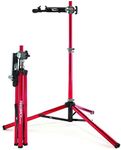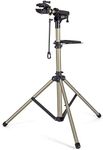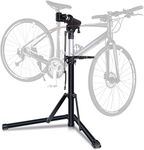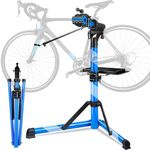Buying Guide for the Best Bicycle Repair Stands
Choosing the right bicycle repair stand can make maintaining your bike much easier and more comfortable. A good repair stand holds your bike securely at a convenient height, freeing up your hands and allowing you to work on your bike safely and efficiently. When picking a repair stand, it's important to consider how and where you'll use it, the types of bikes you own, and how often you plan to perform maintenance. Understanding the key features will help you select a stand that fits your needs and makes bike repairs a breeze.Clamp Type and CompatibilityThe clamp is the part of the stand that holds your bike in place. It's important because it needs to grip your bike securely without damaging the frame or components. Clamps come in different shapes and sizes, and some are designed to fit a wide range of tube diameters, while others are more specialized. If you have bikes with unusual frame shapes or very thick or thin tubes, look for a stand with an adjustable or universal clamp. For most standard bikes, a basic clamp will work, but if you have carbon frames or delicate finishes, consider a clamp with soft, non-marring jaws.
Height AdjustabilityHeight adjustability refers to how much you can raise or lower the stand to suit your working position. This is important because it allows you to work comfortably, whether you're standing or sitting, and to access different parts of the bike easily. Some stands offer a wide range of height adjustments, while others are more limited. If you plan to do a lot of repairs or want to avoid back strain, choose a stand with a good range of height adjustment. If you only do occasional maintenance, a fixed-height stand may be sufficient.
Stability and Base DesignStability is crucial for safety and ease of use. The base design determines how steady the stand will be, especially when working on heavier bikes. Tripod bases are common and offer good stability on uneven surfaces, while flat or two-legged bases may be more compact but less stable. If you have a heavy bike, such as an e-bike or mountain bike, or if you plan to use the stand outdoors or on uneven ground, look for a stand with a wide, sturdy base. For lighter bikes and indoor use, a more compact base may be adequate.
Portability and StoragePortability refers to how easy it is to move and store the stand when not in use. Some stands fold up compactly and are lightweight, making them easy to transport or store in small spaces. Others are heavier and more robust, designed for permanent setups. If you need to take your stand to races, group rides, or store it in a small apartment, look for a lightweight, foldable model. If you have a dedicated workshop space, a heavier, more stable stand may be preferable.
Weight CapacityWeight capacity indicates the maximum weight the stand can safely hold. This is important to ensure the stand can support your bike without risk of tipping or breaking. Stands with higher weight capacities are suitable for heavier bikes like e-bikes or downhill mountain bikes, while lower capacity stands are fine for road bikes or kids' bikes. Always check the weight of your heaviest bike and choose a stand that can handle it comfortably.
Rotation and Angle AdjustmentRotation and angle adjustment allow you to spin or tilt your bike while it's in the stand, making it easier to access different parts without removing the bike. Some stands offer 360-degree rotation and multiple angle settings, while others are more limited. If you plan to do complex repairs or want maximum flexibility, look for a stand with full rotation and easy angle adjustment. For basic cleaning and minor repairs, limited adjustment may be sufficient.



















